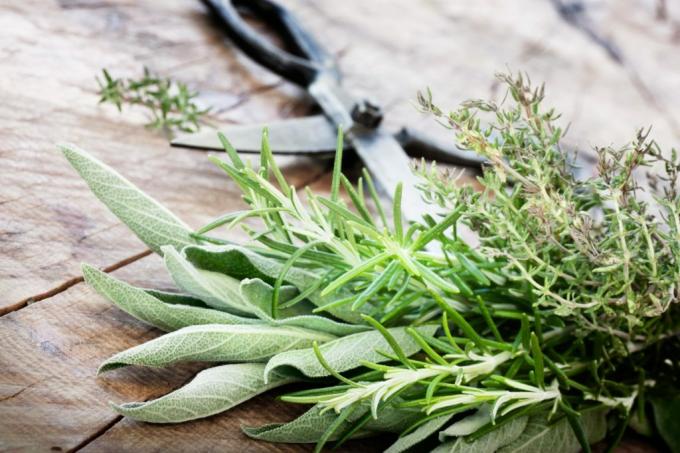Fresh herbs from the garden season dishes twice as well. The time of harvest has a major impact on taste and aroma. Learn how to harvest your herbs properly here.

A few things are critical to harvesting herbs properly. The time of day, weather and season, for example, have a significant impact on the ingredients. The manner of harvesting, on the other hand, plays an important role in the further growth of your herbs.
When is the best time to harvest herbs?
Freshly harvested herbs taste best. Fortunately, evergreen herbs can be harvested all year round. Especially in the cold season is a little fresher rosemary (Rosmarinus officinalis), sage (Salvia) or thyme (thymus) a welcome relief. However, since these herbs have stopped growing in the winter months, you should of course not be too rigorous when harvesting and only snip off a little fresh green from time to time.
The harvest is more productive in spring. Then everything starts to sprout and you can strike properly with a clear conscience. Deciduous and annual herbs can now also be harvested. The best time for this is before flowering - that's when the aroma content is highest. At flowering time, on the other hand, the plant begins to focus all of its energy on flowering. This also reduces the content of aromas. However, you can still harvest many herbs such as thyme or basil during or after flowering. Then they are a little less aromatic, but still more intense than dried herbs. However, some deciduous herbs such as parsley or wild garlic should not be cut after flowering, as they then store unhealthy substances in their cells.

But the time of day and the weather also have an impact on the taste of your herbs. The plants that have enjoyed a lot of sun and little water in the last few days have a particularly large amount of aromatic substances. Herbs that have been harvested after a series of sunny days taste the most intense. For most, it is true that they should be harvested in the morning, as soon as the last dew has dried. Some believe that the gravity of the moon also has an influence on the ingredients in the herbs, and therefore harvest according to the lunar calendar. According to this, herbs should be harvested during the waxing moon.
However, it is not only the time of harvest that is decisive for aromas and ingredients. The most important factors are the weather and the substrate. And since there is certainly little you can do about the weather, you should pay special attention to the earth. Special herbal soils like ours Organic herb & seed soil from Plantura offer your herbs optimal conditions so that they can fully develop their aroma. Our Plantura herb and seed soil in organic quality is humic and has a pH value in the acidic to neutral range - just right for your herbs. In addition, the earth is a product that is particularly climate-friendly in production, as it is completely peat-free and organic. Your herbs will find perfect conditions.

Harvest herbs correctly: instructions
The term "herb" is extremely far-reaching. Numerous plant species are summarized under this term. Nevertheless, some general rules for harvesting can be established:
- Always use clean and sharp tools such as knives or scissors for harvesting. The herbs can then quickly close the wound and are less susceptible to pathogens.
- For the highest aromatic content, you should harvest herbs on a sunny morning.
- Herbs harvested before flowering taste best. Some types such as wild garlic (Allium ursinum) or parsley (Petroselinum crispum ssp. crispum) even store unhealthy substances from the time of flowering.
- Evergreen herbs can be harvested even in winter. Then, however, rather timidly, because they have stopped growing at this time of the year.
- Prune shoots on woody species: Harvest at rosemary (Rosmarinus officinalis), thyme (Thymus vulgaris) and Co. the shoot tips. The leaves are particularly delicate. In addition, the plants branch out and improve their growth habit.
- at basil (Ocimum basilicum) you should always cut off the entire shoot tip. This allows the plant to recover and sprout again. When picking off individual plants, the plant becomes bare and weakened. You can also delay flowering by cutting off the shoots.
- In many annual species such as parsley (Petroselinum crispum ssp. crispum) you should first harvest the older leaves so that the plant still has enough healthy leaf area available.
- chives (Allium schoenoprasum) can be rigorously cut off below. It drives out fresh and new. It also delays flowering. Before the plant dies down in the fall, you can harvest all of the remaining chives and freeze them for the winter.
- The flowers of herbs are also usually edible and can be harvested. They are ideal as a decoration in salads and dishes.

If you don't just want to use your herbs fresh, but want to stock up for the winter, then read this article to find out how Dry and preserve herbs.
